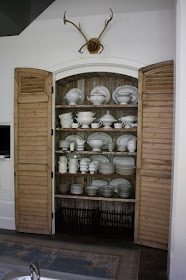I recently did a post about the marble topped presentation tables used by French butchers that look so beautiful in a French style kitchen. However, nothing quite warms up a kitchen like a well worn French butchers table. This blog post is dedicated to introducing you to the ‘billot de boucher, ( pronounced bee-o de booshay). This style table with it's thick slab top was a preparation table, ideal for tasks to get the meat ready to be displayed in the butcher's window. They were usually made of beech, oak, or maple banded with iron braces. The billot de boucher was usually double sided with a carved scalloped apron over large drawers for holding knives and other butcher's tools. Decorated with bronze cow head details on the backboard this table sat on four fluted legs.
The ‘billot de boucher is the perfect accent for you rustic French kitchen and a real conversation piece for your home. They are expensive so if you have one or are considering one for your kitchen I am green with envy.
The French butcher table (billot de boucher) was designed to last for decades. As with most French furniture this piece was functional yet aesthetically appealing as well. This butcher table has the traditional shaped skirt typical of the earlier blocks and a beautifully decorative detail.
The most valuable are the large oak French butcher's tables built in the 19th century as they are considered the most rare. Billot de bouchers that include features such as a knife holder or storage drawers are also considered to be more valuable.
The French billot de boucher had a backsplash usually decorated with a shield (or in this case a shell) in the center and bronze cow heads on the pediments. Also there might be an original enameled maker's plaque still in place.
Hard to believe that these wonderful French butcher's tables were at one time just business furniture. Now thought of as a beautiful element that combines functionality and aesthetics, their character helps this piece anchor your French kitchen.
Aged cow head details on backboard of this billot de boucher. This one is made of wood instead of bronze.
The surface of the billot de boucher provided ample working space for one or two butchers.

A French butcher's table is a lovely rustic accent table that is perfect for the kitchen but would look equally great in a foyer or hallway.
via Pinterest
Muriel Priou / Photo : Sophie Lloyd....via Elle maison
A French butcher's table is a wonderfully functional piece and perfect for the kitchen of someone who really enjoys cooking.
The fundamental element of the billot de boucher is obviously the cutting board made of pavers ( pieces of wood) that have a thickness ranging from 8-20 cm. The plateau is surrounded by stainless steel brackets that hold the wooden elements tight to each other.
A beautiful single butcher's table, still with all the elements of the double table.
Even without a backsplash this French butcher's table is an asset to any interior.
www.traditionalhome.com
This French butcher's table has drawers and also shelves for storage.
1stdibs.com
Authentic Original Antique French billot de boucher - c.1890
designmixer.wordp...
This French butcher's table has drawers and also shelves for storage.
1stdibs.com
Authentic Original Antique French billot de boucher - c.1890
designmixer.wordp...
16lstreet.blogspot.com
There is no mistaking an antique billot de boucher. It will definitely be worn in the center from all the use it has gotten over the years. Don't let anyone fool you....it will be bowed in the center!
There is no mistaking an antique billot de boucher. It will definitely be worn in the center from all the use it has gotten over the years. Don't let anyone fool you....it will be bowed in the center!
Click here to see the previous post
http://eyefordesignlfd.blogspot.com/2016/01/decorate-with-collections-of-creamy.html
This blog post was published by Lisa Farmer









































































